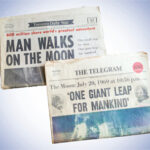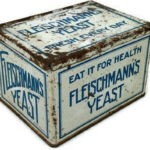The history of paper and paper-making
as Kimberly-Clark told it in the 1930s
Little known facts about paper and paper-making were wonderfully woven together to create an intriguing advertising campaign promoting Kimberly-Clark’s then principal product, paper
What can you say about paper? How often do you even think about paper when you pick up a newspaper, thumb through a periodical, throw away a flyer, read a good book. Kimberly-Clark Corporation just owned paper mills 150 years ago; 90 years ago it found a way to intrigue magazine readers about the history of paper using references to historic “firsts” with the intention to draw them into the real message—that Kimberly Clark’s Kleerfect paper is “a first” and, hence, it is The Perfect Printing Paper. Did they pull it off?
We begin with headlines from the campaign, then we examine two of the advertisements in greater detail
No one listened to the Earliest Writer on Democracy until he feigned madness
A Pope’s fastidiousness gave modern Advertisers rotogravure printing
In 1799 LOUIS ROBERT made possible the page you are now reading
6,000 Years ago in EGYPT it took 500 years for a book to circulate
It took the world Thirty-Five years to profit from the disgrace of England’s Greatest Statesman
A Thrifty Scotch Jeweller showed type founders how to cut the cost of printing
To Aztec culture, the printing press was added in 1539
Type was saved from illegibility when two printers were saved from starvation
Printing’s second greatest discovery was made when Congress overworked two lawyers
In Caxton’s time England had no paper mill
In 1839 Daguerre’s carelessness gave the world photography
A preacher brought the first printing press to America
World’s oldest book was a memorial
When Baskerville printed Milton’s “Paradise Lost”
America’s first paper mill – 1690
In 1589 Plantin proved quality printing need not be costly
Think what happens to Paper when the presses start to roar
Froben, in 1514 A.D. put authorship on a cash basis
It took the art of the painter Van Eyck to make this page legible
Early printer accused of magic
Because Napoleon tried to conquer England this magazine was made possible.
The copywriter’s challenge? To create the headline, the illustration, tell the story and then to bridge to extol the benefits of printing on Kleerfect paper.
The headline in the first advertisement—from Fortune Magazine, August 2934— reads:
The Start of Printing this Page goes back to 1799
The illustration portrays four men—in what purports to be a laboratory—experimenting with a battery.

Here is how the copywriter headlined a little known fact about the history of paper, and bridged to the benefits of printing on Kleerfect paper.
The start of printing this page goes back to 1799
In 1799, Alessendra Volta of Pavia, constructed the first electric battery. William Cruickshank and J.F. Daniell of England improved Volta’s device and in 1837 Thomas Spenser of Liverpool, while experimenting with a Daniell battery, made an accidental discovery that led to electrotyping.
Spenser just happened to use a copper penny for the positive pole of his battery and upon this penny was disposited a layer of copper from the copper sulphate solution in the battery. This layer was torn off accidentally and Spenser found this shell to be an exact duplicate of the head and lettering on the penny, as smooth and sharp as the original.
Later, Spenser impressed a form of type upon a sheet of lead for eight days and got a copper shell one-eighth of an inch thick. This was the world’s first electrotype. Electrotyping is one of the developments that made modern printing—printing on a large scale at low cost—possible.
The recent development of Kleerfect—The Perfect Printing Paper—is the latest factor in the production of fine printing at low cost.
Are you intrigued? The story from the history of paper has now been set out, time to bridge into the outline of benefits that has begun with the reference to Kleerfect. What was Kleerfect, the reader asks and the copywriter answers:
The recent development of Kleerfect—the Perfect Printing Paper—is the latest factor in the production of fine printing at low cost. First of all, in making Kleerfect, special processing eliminates two-sidedness of surface and color for all practical purposes and makes printing of uniformly high quality possible on both sides. Kleeperfect has strength and opacity. It possesses a neutral color that gives proper contrast with the greatest number of printing inks and types of illustration…a non-glaring color that is easy on the eyes and permits the maximum true reproductive power of one to four colors.
Finally, the call to action:
See samples of quality printing on Kleerfect. Write us for examples or the name of the nearest paper merchant. Address our Advertising in Chicago, please

Wondering about electrotypes? Electros are duplicate plates of engravings and/or type that letterpress printers use in long press runs.
The second advertisement about the history of paper—from Fortune Magazine, September 1935—features a montage depicting the greatness of Alexander the Great and the headline
“The World’s Map was re-made by a book that only one man read”

How was the World’s Map remade by a book that only one man read? The copywriter explains:
Alexander the Great was preparing to cross the Ganges. Spies had warned him that a hostile army of 80,000 horse, 200,000 foot, 8,000 armed chariots, and 6,000 fighting elephants was encamped on the other side.
But this did not trouble Alexander as much as the news that Aristotle was preparing for publication the treatise on Government which had taught Alexander how to rule as well as conquer.
The advertisement then tells the reader that Aristotle died before his project was completed and when Alexander died, the reader is asked to believe that his empire disintegrated because Aristotle’s treatise hadn’t been published.
“You have not done well,” Alexander wrote his old tutor, “for what is there now we excel in if the things we have been instructed in are laid open to others.” Alexander’s jealousy was unwarranted. Because there was no printing, Aristotle died before his project was completed. As a result, when Alexander died, no one had been educated to succeed him…the empire he had created disintegrated. And not until the writings of Aristotle were rediscovered and published hundreds of years later did the great political and scientific truths they presented come again to serve man and form the foundation for the renaissance which started our modern era.
Really? But wait, there’s more.
Thus from the earliest times it has been evident that until the art of printing developed, man was incapable of consistent progress…and that every lasting advance in civilization has been matched by an advance in printing. Today the most recent and revolutionary advance in printing is Kleerfect—the Perfect Printing Paper.
The bridge to the benefits has been achieved: now to extol the benefits of Kleerfect. Read for yourself how the benefits are the similar to those in our first advertisement but there are some new benefits and the benefits we have seen above are expressed differently.
Kleerfect makes possible, at far less cost than formerly, printing of equally high quality on both sides of the same sheet. For in Kleerfect two sidedness of surface and color have been banished for all practical purposes.
Kleerfect’s color is neutral, glare eliminating…keyed to bring the maximum effectiveness to reproductions of illustrations in one to four colors. Kleerfect’s strength is ample for the fastest presses…its opacity great enough to prevent show-thru of heavy solids…its ink absorption balanced to give thorough coverage at high speeds.
In the closing paragraph we learn the intended audience for these advertisements.
If you are a publisher or an advertiser, you owe it to yourself to see samples of printing on the new and Perfect Printing Paper—Kleerfect. A request to our advertising office in Chicago will bring them to you.

You will find more about the history of paper and paper-making on the website of Pixartprinting, a U.K. company specialising in providing customised online printing services, producing magazines, catalogues, labels, packaging, printing on textiles and much more. Their online shop is the largest web-to-print operation in Europe.
On the website’s blog you will find:
The history of paper: from its origins to the present day by Sarah Cantavalle
A journey around an ancient paper mill by Giovanni Blandino
Kimberly-Clark Corporation, once the operator of paper mills producing printing paper primarily to printers, is among the top 10 forest, paper and packaging products companies in the world. Products include Kleenex facial tissue, Kotex feminine hygiene products, Cottenelle, Scott and Andrex toilet paper, Wypall utility wipes, Kim Wipes scientific cleaning wipes, and Huggies disposable diapers and baby wipes.
The Printing Times invites you to review this post about Kleenex.









